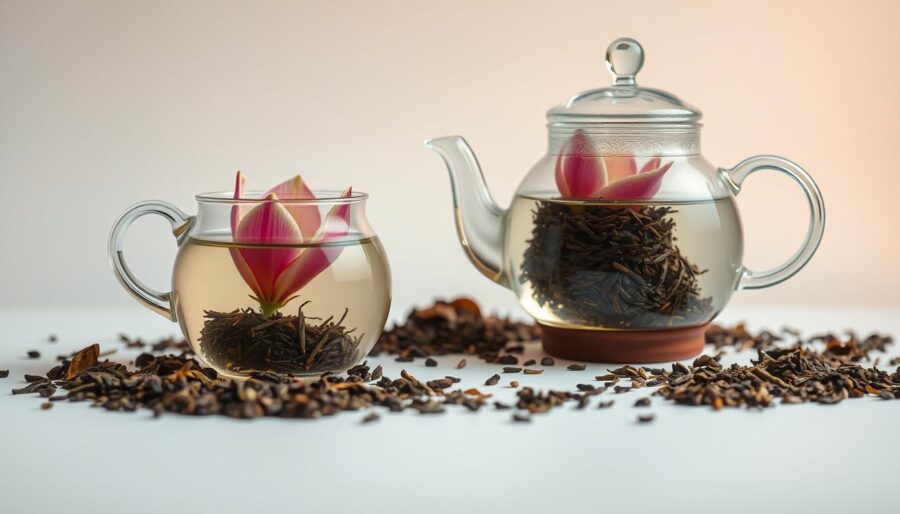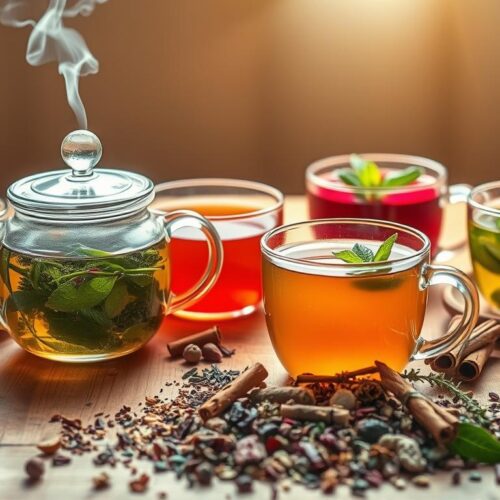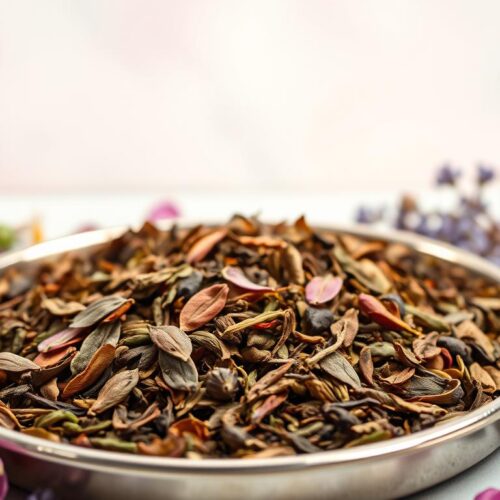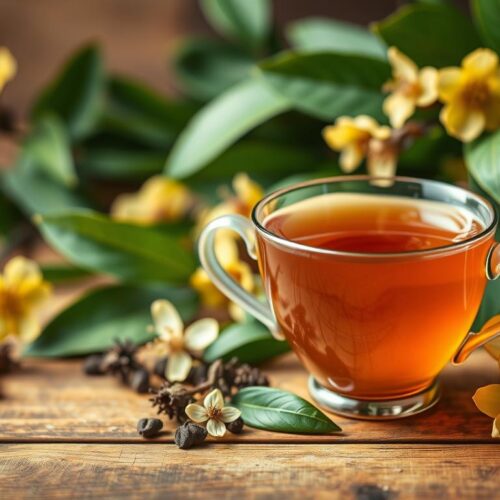Have you ever seen the magic of blooming tea, also called flowering tea? It’s a special kind of loose-leaf tea. It’s not only tasty; it offers a stunning show as it opens up in your cup. Made with fine green tea leaves and edible flowers, each bloom changes into a beautiful display, pleasing your taste buds and eyes.
This guide will take you through the history, how to make it, and why it’s so special. By the end, you’ll know how to enjoy flowering tea fully. It’s a charming touch for any tea lover’s collection.
What is Blooming Tea?
Blooming tea is a mix of beauty and flavor, loved by people everywhere. It’s made by blending top-notch green tea leaves with pretty edible flowers. These are all put together by hand to form something special. When you add hot water, they open up in your cup like flowers, making a wonderful show.
But it’s not just about looks; blooming tea tastes amazing too. As it steeps, the tea gives off great flavors and smells. This happens because the tea leaves let go of oils and stuff that make your tea better.
More and more people are choosing blooming tea because it’s fancy and tastes good. If you like watching the tea change as it brews, you’ll love this. It’s great for having friends over or when you want to treat yourself. Blooming tea is a fun way to shake up your drink choices.
The Benefits of Blooming Tea
Blooming tea is more than just a pretty sight. It’s packed with antioxidants that defend against cell damage. These helpful substances support your health and may lower your chance of developing long-term illnesses.
But there’s more to blooming tea than just its health perks. It includes natural elements that help you relax and feel good. Enjoying a cup is a perfect way to calm down after a busy day. This tea also keeps you hydrated, which is essential for your body to work right.
When you pick blooming tea, you often get a drink that’s free of GMOs and gluten. It’s an excellent choice for those who value quality and cleanliness in their tea. Trying blooming tea can upgrade your tea time, bringing many well-being advantages your way.
How to Brew Blooming Tea Perfectly
Brewing blooming tea is an art that combines beauty and taste. Start by using a clear glass teapot. This lets you watch the blossoms open up.
Heat your water to just the right temperature, between 190°F and 200°F. Use high-quality water for a better taste. Then, pour this hot water over a blooming tea ball in your teapot. Let it steep for 5 to 7 minutes to fully bring out the flavor.
As the tea steeps, you’ll see the flowers open beautifully. This makes serving blooming tea a very special moment. You can steep the same blooming tea ball up to three more times. Each brew will reveal more flavors.
Before serving your blooming tea, think about adding some sweetness. A little honey or agave syrup can make it taste even better. Enjoy this fragrant beverage and share the unique experience with others.
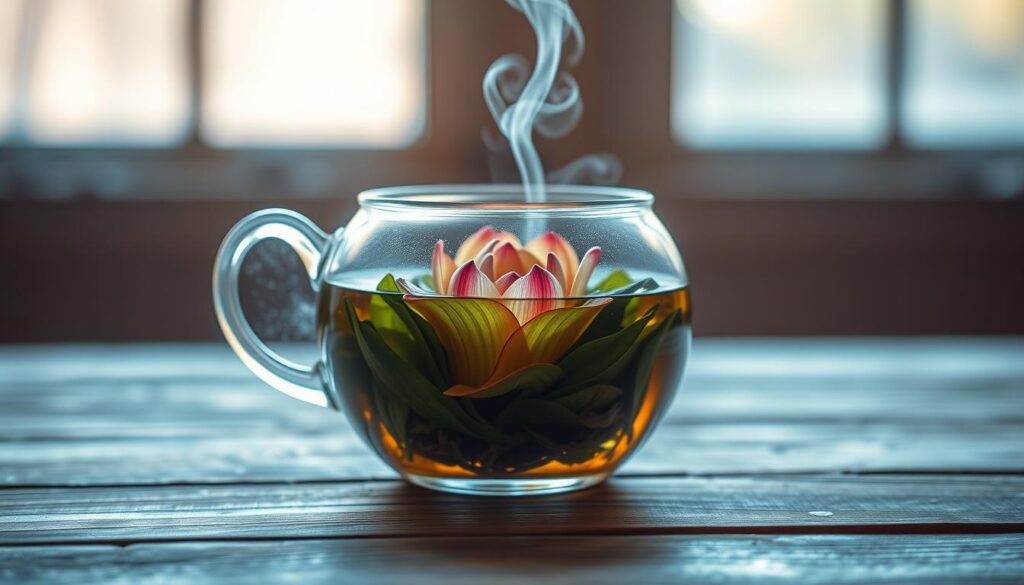
The Best Types of Blooming Tea
Looking into the world of blooming tea reveals many types. Each kind offers a unique experience with its own flavor and visual beauty.
Teabloom stands out with its beautiful blooming teas. Their teas are more than just drinks; they’re a feast for the eyes.
Here are a few blooming teas you might love:
- Jasmine Flowering Tea: This tea mixes green tea and jasmine. It’s known for its fragrant and refreshing taste.
- Chrysanthemum Blooming Tea: It’s sweet, beneficial for health, and has a lovely floral scent.
- Peach Blossom Tea: Perfect if you like fruity and floral tastes. It’s peach flavored.
- Hibiscus Flower Tea: A favorite for iced tea fans, it’s bright, tangy, and colorful.
When trying these teas, how you brew them matters. Use water heated between 175°F and 195°F. Let the tea steep for about five minutes. This allows the tea flowers to open up fully. You’ll get to enjoy both their scent and taste.
Pairing Blooming Tea with Food
Pairing blooming tea with food makes both better. To mix them well, think about the tea’s flavors and the food. Matching the tea’s floral taste with the right food can be unforgettable.
For a better pairing, use light blooming teas with starters like bruschetta or sushi. Stronger teas go well with heavy dishes, like grilled meats or stews. Picking the right food can make your tea party special.
At your party, offer different tastes and textures. Here’s how to match blooming tea with food:
- White blooming teas: Pair with light cheeses and fresh fruit.
- Green blooming teas: Go well with sushi, sashimi, or salads.
- Black blooming teas: Best with dark chocolate or dishes like roasted duck.
Plan a menu that brings out the best in both food and tea. Try new combinations and find exciting ways to enjoy them. This will please your guests and show off blooming tea’s charm.
| Blooming Tea Type | Recommended Food Pairings |
|---|---|
| White Blooming Tea | Light cheese, fresh fruits |
| Green Blooming Tea | Sushi, sashimi, leafy salads |
| Black Blooming Tea | Dark chocolate desserts, roasted meats |
| Herbal Blooming Tea | Pastries, cinnamon rolls, roasted vegetables |
Understanding Blooming Tea Ingredients
To dive into blooming tea, it’s vital to know the main parts. The key ingredients are quality green tea leaves and various tea flowers. These elements add to the taste and look of the tea.
The green tea selected is known for its gentle flavor and antioxidants. Flowers like jasmine, lily, and hibiscus are common. They add unique tastes and smells. This enhances how the tea tastes and adds health benefits too.
The quality of blooming tea ingredients matters a lot. Using top-notch green tea leaves and fresh flowers gives a brighter bloom and a stronger tea. Getting these parts from trusted suppliers ensures the tea is flavorful and healthy. So, buying high-quality tea improves your drinking experience and health.
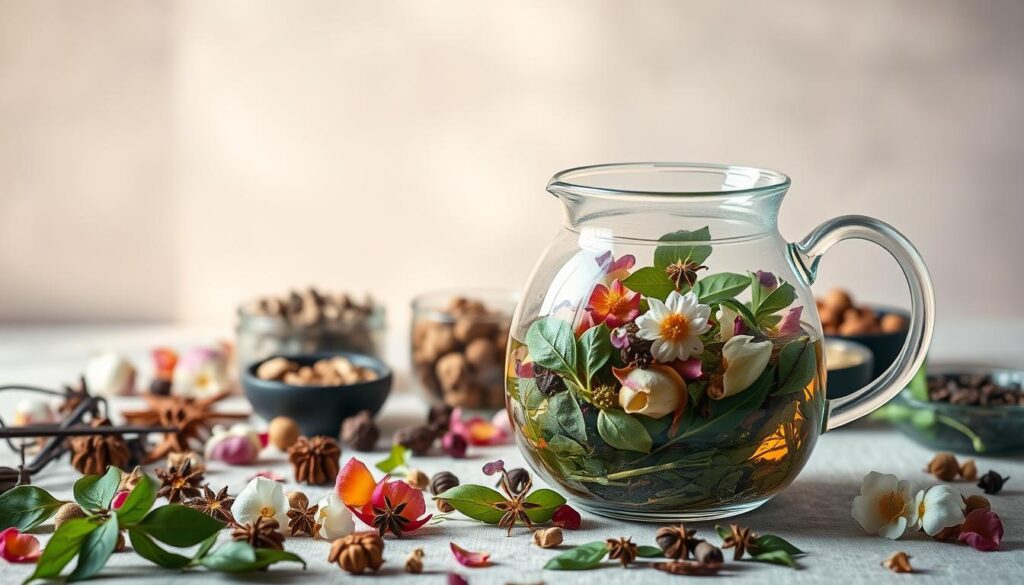
The Art of Serving Blooming Tea
Serving blooming tea is art that makes your tea time special. By choosing the right glassware, everyone can see the tea bloom. A see-through teapot or glass cups are best for this. They let people watch the flowers open and the colors spread.
To make your tea service perfect, follow these tips:
- Choose a calming environment with soft lighting to accentuate the colors of the tea.
- Incorporate natural elements such as flowers or greenery on the table.
- Use elegant trays for serving, enhancing the overall presentation.
Along with traditional ways of serving, try new things. Pair blooming tea with different desserts or snacks. This adds an extra touch of class and makes the flavors even better.
Talk about the tea’s story when you serve it. Tell your guests about where the tea comes from and the flowers used to make it. This makes the experience about more than just drinking tea. It turns it into something memorable.
Caring for Your Blooming Tea Accessories
Taking care of your tea accessories is key to a better blooming tea experience. Keeping them well-maintained means they last longer and work better. If you clean and store them properly, they won’t get damaged and will stay in good condition.
To keep your tea tools in top shape, here’s what you should do:
- Teapots: Always clean your teapot after using it. Use warm, soapy water but steer clear of harsh scrubbers to avoid scratches.
- Tea Mugs: Gently wash ceramic mugs by hand using a soft sponge. For glass mugs, let them cool first to avoid cracks.
- Storage Containers: Keep your tea in containers that are airtight. This protects the tea from moisture and light. Check them often for any damage.
Think about the best way to clean your tea accessories, since different materials need different care. For example, wood items sometimes need oil to stop them from drying out. Meanwhile, stainless steel items are fine with natural cleansers like vinegar or lemon juice.
Looking after your tea equipment is more than just washing them. By setting up a care routine, you make your tea-drinking moments better. Paying regular attention to your accessories keeps them ready for use, letting you enjoy the taste and beauty of blooming tea fully.
Buying Blooming Tea: What to Consider
When you shop for blooming tea, focus on some key things to improve your experience. Start by checking the tea’s source. Reliable companies share how they grow and pick their tea. Choose brands known for their flowering tea to get true, top-notch products.
The quality of blooming tea really depends on its ingredients. Top tea brands will tell you exactly what’s in it. This helps you stay away from unwanted things like artificial flavors. Also, take a close look at the tea flowers used. They can change how the tea tastes and smells.
How the tea is packaged can affect how fresh it stays. Go for brands with moisture-proof packaging to keep the tea’s quality. A tightly sealed package suggests that keeping the tea fresh and flavorful is key for the maker.
To help with your tea buying, check out this table. It lists some of the best tea brands and what they offer:
| Brand Name | Type of Blooming Tea | Notable Ingredients | Price Range |
|---|---|---|---|
| Adagio Teas | Flowering Tea | Jasmine, Green Tea | $10 – $30 |
| Teavana | Blooming Blossoms | Chrysanthemum, Dragon Pearl | $15 – $40 |
| Harney & Sons | Artisan Blooming Tea | Rose, White Tea | $20 – $50 |
Knowing these tips will make buying blooming tea fun and fulfilling. Focus on these details to pick a tea that tastes amazing and offers a beautiful experience.
Exploring Blooming Tea Culture Around the World
Blooming tea is not just a drink, but a worldwide sensation. Its beautiful unfolding and complex flavors make it special. In places like China, where it first started, blooming tea is a big deal at gatherings. People there turn drinking this tea into an art form during social events.
Serving blooming tea in Asia is full of meaning. Watching the tea leaves open and the flowers inside come to life is a treat. It’s a way to bond at special events or family meets. Every sip and bloom can make these moments feel more connected. Some cultures even pair the tea with particular snacks or pots, making the experience even better.
The journey into blooming tea culture is about more than just its taste. It’s about the art and history behind each cup. Whether alone or with pals, knowing about these traditions can make drinking blooming tea even better. By learning about its different traditions, we see its impact worldwide. It truly shows how a simple drink can connect people.

